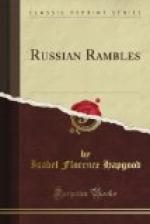No sound of the village reached us in our retreat except the choral songs of the maidens on holiday evenings. We tempted them to the lawn one night, and overcame their bashfulness by money for nuts and apples. The airs which they sang were charming, but their voices were undeniably shrill and nasal, and not always in harmony. We found them as reluctant to dance as had been the peasants at Count Tolstoy’s village. Here we established ourselves for the harvest-tide.
II.
Our life at Prince X.’s estate on the Volga flowed on in a semi-monotonous, wholly delightful state of lotus-eating idleness, though it assuredly was not a case which came under the witty description once launched by Turgeneff broadside at his countrymen: “The Russian country proprietor comes to revel and simmer in his ennui like a mushroom frying in sour cream.” Ennui shunned that happy valley. We passed the hot mornings at work on the veranda or in the well-filled library, varying them by drives to neighboring estates and villages, or by trips to the fields to watch the progress of the harvest, now in full swing. Such a visit we paid when all the able-bodied men and women in the village were ranged across the landscape in interminable lines, armed with their reaping-hooks, and forming a brilliant picture in contrast with the yellow grain, in their blue and scarlet raiment. They were fulfilling the contract which bound them to three days’ labor for their landlord, in return for the pasturage furnished by him for their cattle. A gay kerchief and a single clinging garment, generally made of red and blue in equal portions, constituted the costume of the women. The scanty garments were faded and worn, for harvesting is terribly hard work, and they cannot use their good clothes, as at the haying, which is mere sport in comparison. Most of the men had their heads protected only by their long hair, whose sunburnt outer layer fell over their faces, as they stooped and reaped the grain artistically close to the ground. Their shirts were of faded red cotton; their full trousers, of blue-and-red-striped home-made linen, were confined by a strip of coarse crash swathed around the feet and legs to the knee, and cross-gartered with ropes. The feet of men and women alike were shod with low shoes of plaited linden bark over these cloths.




